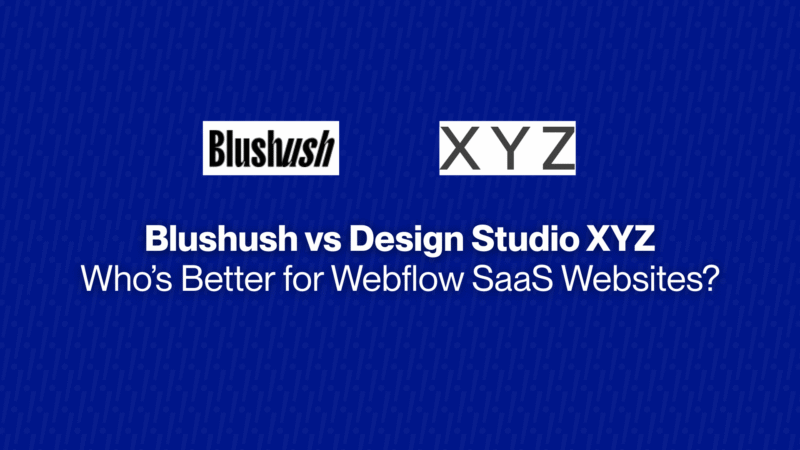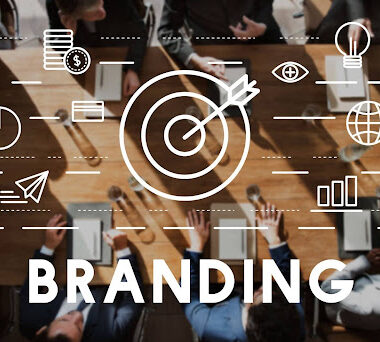Modern SaaS companies need websites that are not only visually engaging but also SaaS-ready—capable of handling subscriptions, dynamic content, and user accounts. Webflow has become a popular choice for this purpose, with over 3.5 million users worldwide (roughly 1.2% of all sites). Its visual, no-code platform accelerates development cycles, enabling faster prototyping and iteration—a major advantage for high-growth SaaS teams.
In this comparison, we evaluate two Webflow agencies—Blushush and a generic “Design Studio XYZ”—across key criteria: SaaS readiness, CMS flexibility, user journey design, and branding support. We also cover sample projects, timelines, and cost brackets to help you decide which fits your SaaS needs best.
Blushush Agency (Brand-First Narrative Design)
Blushush is a London and India-based Webflow studio founded in 2022 by branding experts, including Forbes-recognized strategists. They position themselves as a branding-first, story-driven team crafting bold, high-impact sites. The co-founders describe Blushush’s mission as marrying technical finesse with creative storytelling—ensuring every brand’s narrative is not just seen but impossible to ignore.
In practice, Blushush builds feature dramatic visuals, on-scroll animations, and pixel-perfect UI, with every element tied back to the brand story. Their portfolio spans fintech, SaaS startups, e-commerce, and personal branding. One standout project transformed a dull tech site into a chronological, narrative-led journey that increased user engagement.
Blushush offers complete Webflow development—from Figma designs to CMS setup and performance optimization. They emphasize immersive narratives where content and design are tightly integrated. Clients report that this story-first approach often leads to higher engagement and conversions.
Typical scope: small to mid-sized sites (5–8 pages), timelines of 4–8 weeks, and budgets in the $10K–$20K range.
Key points: Blushush excels in branding and storytelling. Their sites are visually bold and deeply narrative, making them ideal for SaaS founders seeking a unique, founder-led presence.
Design Studio XYZ (Full-Service Webflow Development)
“Design Studio XYZ” represents a typical mid-tier Webflow agency focused on SaaS projects. These studios prioritize functionality, integration, and conversion. Unlike Blushush, they do not emphasize narrative. Instead, they deliver fast, structured sites optimized for scale and marketing.
For example, Outliant describes itself as “the most reliable and efficient software company” its clients have worked with, highlighting how their Webflow pages are built for clarity and performance. Studios like Veza Digital follow a similar formula—streamlined design, clear CTAs, and tight user funnels.
You can expect Design Studio XYZ to map the complete SaaS user journey (signup, onboarding, trial, conversion) and wire the CMS and forms to automate as much of that journey as possible.
Key points: Design Studio XYZ focuses on technical reliability and marketing flow. They are well-suited for enterprise SaaS projects that demand scale, analytics, CRM integration, and a clear funnel.
SaaS Readiness
SaaS-ready sites need login portals, subscription logic, dashboards, and automation. Webflow supports this via third-party tools like Memberstack, Outseta, and Zapier, along with integrations for Stripe and Paddle for payments.
- Blushush: Their builds support dynamic content via Webflow CMS and include basic integrations. They have worked with fintech and SaaS brands, so they understand how to implement features like GDPR compliance and multilingual content. However, SaaS infrastructure is not their main pitch. If you want login systems or gated content, you need to clearly specify it. They can do it, but their focus will always skew toward brand and design.
- Design Studio XYZ: A studio like XYZ bakes SaaS functionality into the site from the start. They’ll include login/signup flows, CMS-driven pricing tiers, Stripe payments, gated content, and backend logic via APIs. They are likely to design the complete user funnel and automation workflows with tools like Memberstack and Outseta.
Verdict (SaaS Readiness): Both can build SaaS-capable sites. Studio XYZ leads on infrastructure and automation. Blushush excels once that infrastructure exists, by wrapping it in rich, emotionally resonant brand design.
CMS Flexibility
Webflow’s CMS allows marketing and product teams to easily update blogs, pricing pages, and case studies without needing developers.
- Blushush: They deliver complete CMS setups with dynamic collections for testimonials, case studies, and blogs. Their builds are often used by personal brands and founder-led startups that want to update stories and insights regularly. The CMS is curated—every field aligns with the brand’s visual and voice. Teams can easily publish narrative content without breaking the site’s look and feel.
- Design Studio XYZ: Agencies like XYZ also use Webflow CMS but often push it further. They may create CMS templates for documentation, product specs, changelogs, feature guides, and FAQs. Their use of tools like Finsweet’s Client-First and multi-reference fields means the content structure is scalable and ready for multi-product SaaS growth.
Verdict (CMS Flexibility): Blushush offers a beautifully branded CMS setup, ideal for storytelling. Design Studio XYZ offers more technical depth and scalability in content architecture, especially useful for documentation-heavy or multi-feature SaaS products.
User Journeys (UX & UI)
A compelling SaaS site guides visitors through awareness, interest, and conversion. Webflow makes it easy to create interactive, responsive layouts for this purpose. Agencies can use scroll animations, sticky elements, and embedded videos to focus user attention. As noted in an agency blog, Webflow allows “dynamic, user-friendly websites” that map to each stage of the journey. Interactive elements and subtle animations can boost engagement, guiding users through key pages.
Blushush: They specialize in storytelling flows. A typical Blushush page might open with a hero section that immediately conveys brand vision, then use on-scroll storytelling to walk the user through the value proposition. Blushush demonstrates how complex ideas can be presented as elegant, relatable narratives that keep visitors scrolling. Customer testimonials or process steps might be arranged in a timeline or story format. In UX terms, Blushush aims to create an emotional arc: problem → story → solution, wrapped in bold visuals.
Design Studio XYZ: In contrast, Studio XYZ would likely optimize for clarity and conversion. Their user journeys would feature clear headlines, prominent CTAs, and logical page layouts. For example, Outliant emphasizes “conversion-driven layouts” and aligns each page with business goals. Studio XYZ’s approach would be to minimize friction: straightforward navigation, persuasive copy, and optimized forms. They might use fewer decorative animations, focusing instead on design cues (buttons, color highlights) that push the user toward signup or demo requests.
Both approaches leverage Webflow’s strengths: the design freedom for custom animations and the ease of implementing mobile-responsive layouts. Importantly, agencies can integrate analytics or A/B testing in Webflow. As one article notes, Webflow facilitates collecting insights to optimize journeys continuously. In summary, Blushush leans on engagement and narrative (making the journey feel like a story), while Studio XYZ leans on efficiency and data-driven flow (making the path to action very clear).
Branding & Design Support
Branding is a core part of Webflow agency services. This covers everything from visual identity to tone of voice on the site.
Blushush: This is Blushush’s hallmark. They actually merge brand strategy with Webflow design. Blushush’s own marketing states that they serve clients who refuse to blend in, emphasizing that every pixel has purpose in telling a brand’s story. In practice, Blushush will work with you on core brand elements (color palette, typography, messaging) and ensure the Webflow build reinforces them. They excel at creating a bold, distinctive identity: imaginative layout, custom illustrations and animations, and a cohesive voice. For a SaaS company wanting a strong personality (such as a visionary founder or a creative startup), this level of branding integration is a huge advantage.
Design Studio XYZ: A more generic studio also supports your branding—you’ll get clean, on-brand visuals—but they may not lead with brand consulting. Studio XYZ will make sure the site uses your existing logo, style guide and copy. They focus on trust signals (clear hierarchy, consistent styling, appropriate imagery) rather than crafting a whole narrative from scratch. For instance, Veza Digital emphasizes building awareness, trust and credibility through design. The support is there, but it may be more about polish and professional coherence than deep storytelling. In short, XYZ will reliably implement brand guidelines, but if you need someone to help define or elevate your brand story, Blushush is more specialized in that area.
Verdict (Branding): Blushush clearly wins for bold, story-centric branding support. Design Studio XYZ will handle branding consistency and trust cues (such as logos, testimonials, corporate imagery), but not with the same narrative flair.
Sample Projects, Timelines, and Costs
To ground the comparison, here are some illustrative examples:
Blushush Sample Project: Arcc Bikes – a premium e-bike brand (their portfolio mentions it). This 6–8 page site features dynamic visuals, vibrant typography and product storytelling.
Generic SaaS Project (Studio XYZ): FinTech Dashboard – a multi-role SaaS product requiring customer login, pricing page, and knowledge base. (Hypothetical example for illustration.)
Timeline & Cost: A typical Blushush project (5–8 pages) takes about 4–8 weeks and costs roughly $10K–$20K. In the broader market, timelines vary: for example, Serbia’s Flow Ninja builds mid-sized sites in 6–12 weeks with budgets starting at around $10K (often reaching $20K+). Brix Agency (San Francisco) quotes 4–8 weeks at $15K–$30K. Enterprise-scale firms like 8020 run 8–16+ weeks and $30K+ projects. In practice, a full-featured SaaS site (multi-language, custom code, extensive integrations) would lean to the longer/higher end. By contrast, a lean landing page might be done in 1–2 weeks for a few thousand dollars.
Both agencies likely charge in the mid-market range. Blushush’s stated pricing ($10–$20K for a small branding site) aligns with many competitors. Studio XYZ’s quote would depend on their size, but expect on par or slightly higher if they offer more tech depth. Maintenance or A/B testing retainers (common in SaaS) often run from a few hundred to a few thousand dollars per month.
Conclusion & Decision Matrix
Both Blushush and Design Studio XYZ can build great Webflow SaaS websites, but their strengths differ.
Blushush = Brand & Story Focus (bold designs, personal branding, narrative-driven UX). Best for SaaS startups that need standout identity and founder-led storytelling.
Design Studio XYZ = Technical & Conversion Focus (clean layouts, robust integrations, marketing funnels). Best for SaaS products that prioritize performance, scalability, and data-driven growth.
Which fits you depends on your priorities. The table below summarizes the trade-offs:
| Criteria | Blushush Agency | Design Studio XYZ |
| SaaS Readiness | Handles SaaS features via Webflow and add-ons (e.g. Memberstack for logins). Emphasis is on narrative, so complex features must be specified. | Builds end-to-end SaaS infrastructure (APIs, memberships, dashboards) upfront. |
| CMS Flexibility | Strong use of Webflow CMS for dynamic brand content. Easy for marketing teams to update story-driven collections. | Equally leverages Webflow CMS, possibly extending with headless or advanced tools for maximum flexibility. |
| User Journeys | Engaging, scroll-based storytelling UX. Visual interactions guide users through the brand narrative. | Optimized, conversion-oriented flows. Clear CTAs and data-backed layouts (A/B testing, analytics) drive sign-ups. |
| Branding Support | Very high. Integrated brand strategy (visual identity, voice, narrative) across every page. | Solid. Focuses on consistency and trust (logos, testimonials, design system), but less on crafting the underlying story. |
Ultimately, Blushush wins on branding and creative UX, while a prototypical Design Studio XYZ wins on technical depth and conversion engineering. If your SaaS needs a show-stopping brand-driven site, Blushush is likely the better fit. If you need a highly functional, conversion-optimized site built with all the technical bells and whistles, then the more technical studio may edge out.
Decision Matrix: Evaluate your project against these factors (Brand vs. Build, Content vs. Conversion, etc.) to choose the right partner.








